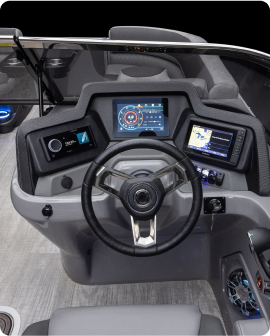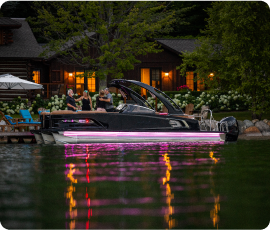Welcome to the boating world, where learning essential boat terminology is critical to confidently navigating the waters. The abundance of unfamiliar words and phrases can be overwhelming for those new to boating. Whether figuring out which side is the port or understanding how the wind blows, these terms are vital for safe and effective communication with your crew.
By mastering these boating terms, you’ll not only feel more comfortable, but you’ll also enhance your safety on the water. Knowing the difference between bow and stern might seem basic, but these words can prevent accidents and ensure smoother sailing experiences. Let’s dive in and uncover the key boating terminology that every novice needs to know.
Understanding the essential parts of a boat is crucial for any new boater. Whether maneuvering into a tight spot or following crew commands, knowing the basic parts and directions ensures a safe and smooth journey.
The bow refers to the front of the boat, while the stern is the back. These terms are frequently used in navigation, so it’s essential to remember them. For example, if someone on your boat tells you to move toward the bow, you’ll know to head to the front. On the other hand, moving to the stern directs you toward the back of the vessel.

Most boats also have a swim platform, a flat surface at the rear, often used for water activities like swimming or diving. Understanding this feature is vital for safety and fun on the water.
Imagine someone calls out, “Bring the boat in from the port side!”—you’ll immediately know they mean the left-hand side. Understanding the starboard side ensures you avoid confusion when someone calls for a maneuver on the right.
Another critical part is the hull, the boat’s main body. The keel at the lowest point provides stability by preventing the boat from tipping. The vertical distance between the waterline and the lowest point of the hull helps determine how safely the boat can navigate shallow waters. Keeping an eye on the minimum depth needed for the boat can prevent grounding accidents.
Mastering these boating terms and parts will significantly improve your communication and handling skills on the water, ensuring you can confidently navigate and dock.
Navigational terms are equally important for safe and efficient boating. One crucial term is the helm, which refers to the wheel or tiller used to steer the boat. The rudder works alongside the helm, controlling the vessel’s direction in the water.
In navigation, one nautical mile is the standard measurement of distance. It’s equivalent to approximately 1.15 statute miles, and understanding this is essential when calculating travel time and fuel use.
Another essential term is bearing, which refers to the direction from your current position to a specific point, such as a buoy or landmark.
Having an accurate bearing ensures you are on course and helps avoid hazards. Dead reckoning is another navigation technique used when systems like GPS fail; it estimates the boat’s position based on speed, direction, and elapsed time.
When sailing, it’s important to understand terms like beam reach, which describes the point of sail when the wind is coming from the side of the boat, making it one of the fastest and easiest points of sail.

In contrast, a dead run occurs when the wind is directly behind the boat, requiring different sail adjustments for optimal movement.
Knowing these navigational terms helps keep your boat on course and ensures you’re prepared for various conditions on the water.
Boating safety is paramount; understanding essential safety phrases can make all the difference in emergencies. One critical phrase is “man overboard.” If someone falls into the water, shouting “man overboard” immediately alerts the crew, prompting them to retrieve the individual quickly.
In more severe situations, the term mayday is used. A mayday call is a distress signal sent over the radio during life-threatening emergencies, alerting other boats and rescue authorities that immediate help is needed.

Another important term is underway, which refers to the boat moving through the water. This term helps coordinate activities among the crew, especially when navigating busy or tricky waters. Anchoring is another vital aspect of safety.
When the boat is anchored, it remains stationary, and phrases like “Let’s drop the anchor” signal the need to secure it.
The masthead light is a required feature for night navigation.
It ensures visibility to other boats and, along with other lights on the boat, helps communicate your vessel’s position and status in the dark, increasing overall safety.
Consider an example: you’re cruising near a lee shore, where the land is downwind of your boat, and someone falls into the water. Yelling “man overboard” immediately prompts the crew to stop the boat and initiate a rescue. Quick and clear communication is critical in preventing a tragedy.
By understanding these safety phrases, you’ll be better prepared to handle emergencies and ensure your crew stays safe on the water.
Clear communication is essential when boating, especially when using a VHF radio. VHF radios are the primary means of communication for boaters, and understanding key phrases will help you stay in touch with other vessels and shore stations effectively.
Common VHF Radio Terms
Several standard terms are used on VHF radios, each serving a specific purpose.
The word “Roger” confirms that you have received and understood a message. It doesn’t mean you agree, but simply that the message has been heard.
“Over” signals that you’ve finished speaking and are waiting for a reply, while “Seelonce” is a command to request radio silence in an emergency.
Understanding these terms ensures that communication on the water remains smooth and efficient.


Communication Etiquette
Following proper etiquette is essential to avoid confusion or miscommunication when using the VHF radio. Always start your transmission by clearly identifying your calling station, followed by your vessel’s name. For example, “Avalon Pontoons, this is Seafarer, over.”
It’s also crucial to speak slowly and clearly, as background noise from wind or waves can interfere with radio signals. Keep messages brief and to the point, and remember that all communications on VHF are public, so respect privacy and avoid irrelevant chatter.
The Impact of Good Communication
Mastering VHF radio communication doesn’t just help you follow maritime rules; it also builds camaraderie with fellow boaters. Effective communication fosters community on the water and ensures everyone’s safety.
Whether signaling to pass another vessel or responding to a distress call, strong communication skills help make boating safer and more enjoyable for everyone.

Learning essential boating terms is a crucial step for any new boater. Understanding these terms can help you become more confident and enhance your ability to communicate effectively with your crew and other boaters. Knowing the difference between port and starboard or how to use a VHF radio properly can significantly impact your boating experience.
As you continue your boating journey, keep expanding your knowledge of these terms and applying them during your time on the water. The more familiar you become with these phrases and concepts, the more enjoyable and safe your boating trips will be. For those interested in further enhancing their boating knowledge, exploring leading pontoon manufacturers can provide valuable insights into innovative designs and features.
Mastering boating terminology can initially seem overwhelming, but it becomes second nature with practice. These terms are more than just words—they are tools to help you navigate the waters confidently and safely.
As you grow more comfortable with boat parts, navigation, and communication, you’ll find that the boating world opens up to new adventures and experiences. Keep practicing, and soon, you’ll speak the sea language fluently.
If you’re considering upgrading your vessel, check out luxury pontoon boats for sale to experience the perfect blend of comfort, style, and performance on the water.
Embark on 50 years of award-winning pontoon excellence with Avalon. Elevate your journey through unrivaled artistry, cutting-edge design, and supreme quality and service.
Copyright © 2024 Avalon Pontoon Boats. All Rights Reserved. Sitemap
Copyright © 2022 Avalon Pontoon Boats. All Rights Reserved. Sitemap
One of our Pontoon specialist or a local dealer near you will contact you to help configure the boat that matches your exact needs.
Thank you for taking the time to contact us with your questions and concerns. We love being available for you electronically. Recently, though, we have begun to receive duplicate emails sent to multiple people in the company. In an effort to increase our efficiency and improve our customer service, we would appreciate it if you use our online contact us form to the right so we can automatically direct your request to the correct people on our team.
If you are in need of service regarding a warranty, please contact your dealer (find your local dealer here). Contact us only if your dealer’s service does not meet your needs.
Thank you,
The Avalon Team
903 Michigan Avenue,
Alma, MI 48801